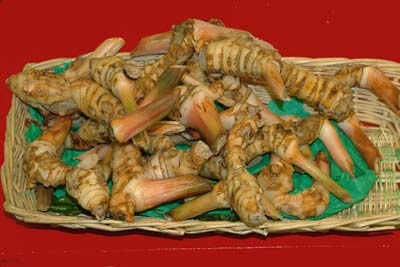
Galangale. The rhizome of a plant of the ginger family, although it is smaller and more shrivelled. It has more translucent, flesh-coloured skin than the rhizome of ginger. It is peeled and grated or thinly sliced and used in the same way that fresh ginger is used, but has a slightly more complex flavour reminiscent of camphor. Greater galangal resembles a cross between ginger and pepper; lesser galangal is more pungent, with cardamom and eucalyptus flavours, whilst kempferia is the strongest.
Taro or colocassia root. Taro is a name used to cover many root crops grown in tropical regions, most commonly Colocassia esculenta. The leaves come from plants cultivated in warm climates both for their leaves and tuberous, potato-like roots, or corms. The roots, the flesh of which may vary from white to pink, have a delicate flavour and can be peeled and boiled, roasted, mashed, fried or included in a stew and look like a pointed swede, often with a ridged surface and protruding roots, with hairy beige or brown skin. They may weigh as much as 2 kg (4¼ lb). The leaves are large and floppy, fan-like and used as a vegetable or in soups. Some varieties of taro grow extra corms which bud on the main corms, or dasheens. These "buds" are known as eddos, particularly in the West Indies. Taro is a good source of high-grade protein. Whole taros with the skin intact are preferable to those that come peeled.
Paddy eel or swamp eel. I saw these for sale in the market in Luang Prabang but the woman who was selling them looked unhappy that I wanted to take a photograph, so I refrained.